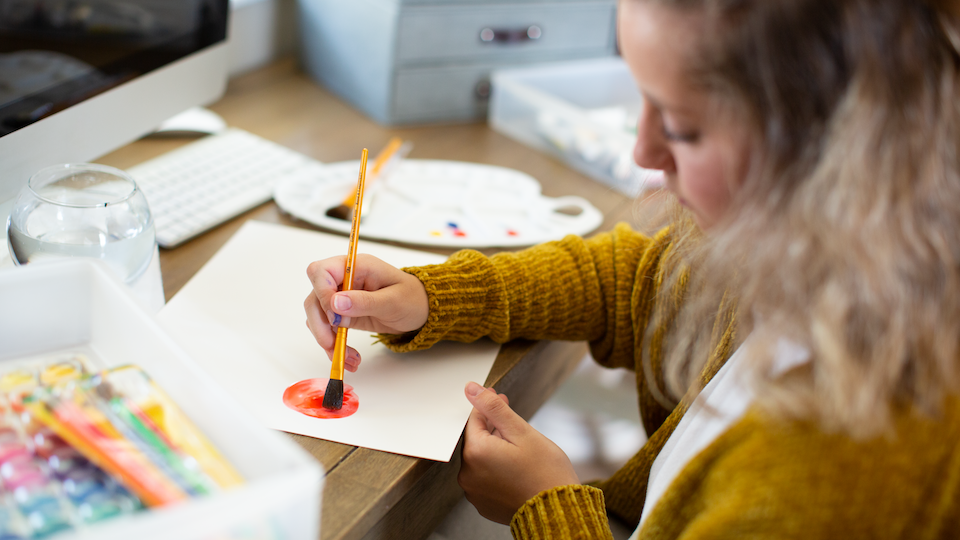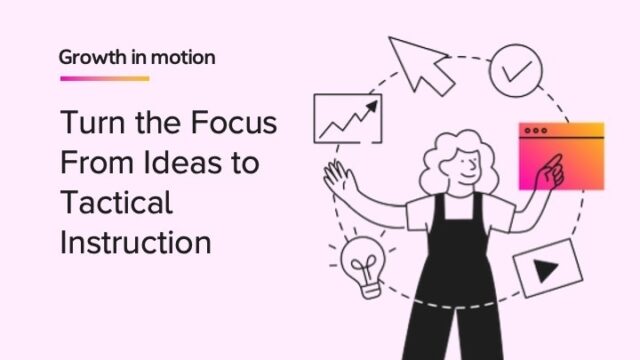
Whether it’s social media posts, book covers, device backgrounds, or graphics on clothing (and I’m just getting started), art is everywhere. And no matter what your students are thinking about doing when they’re older, learning about art can only help them to do it better. It rounds out their education and helps them to understand the world.
Art can have some very direct academic benefits, too. Scientists and mathematicians must be able to draw precise graphs and diagrams. The act of making art involves skills like planning, persistence, and attention to detail—skills that transfer to every discipline or career imaginable. Teachers are already tasked with improving the lives of the students they teach; helping them to develop a love of the arts can help.
7 ways art helps students’ learning
1. Applies to all other subjects
Arts education is broader than learning to, say, draw a portrait or play the violin. “The arts are one way of knowing the world,” write educational psychologist Kimberly Sheridan and colleagues, “as important as the other disciplines to our societal health.” The arts invoke universal skills like creativity and persistence. Studying the arts can help students across every other discipline and help them become humans who are more successful in every aspect of their lives.
Journalist Ginanne Brownell investigated how pervasive the arts are throughout all subjects. “It is largely through the arts that we as humans understand our own history,” she cites as one example. “And yet,” she explains, “the arts don’t lend themselves well to hard data, something educators and policymakers need to justify classes in those disciplines in their budgets.”
The point of the arts is not just to transfer those skills to more heavily assessed subjects like math or literacy. This is a dubious narrative sometimes used to advocate for arts education when it is being questioned. There is no “clear evidence of transfer,” explain Judith Burton et al. “However,” they continue, “a relationship exists between learning in the arts and other disciplines.” The cognitive and behavioral benefits that come from exposure to arts learning can help students in all subjects.
2. Keeps learning motivating
“I have never understood why creative response involving painting easels, block corners, felt boards, and puppets seem to vanish after kindergarten,” writes Regie Routman in Conversations: Strategies for Teaching, Learning, and Evaluating. Play always has a place in the learning experience. Students who are otherwise disengaged may find joy in getting to make art, music, and drama in other subjects. Moreover, playful recreation can be an important part of exploring concepts deeply. In many places around the country, “kindergarten is becoming like the rest of school,” laments computer scientist Mitchel Resnick in Lifelong Kindergarten: Cultivating Creativity through Projects, Passion, Peers, and Play. “I argue for the exact opposite: I believe the rest of school (indeed, the rest of life) should become more like kindergarten.”
One powerful benefit of art is that it can create an entry point for students across different subjects. Artistic and dramatic expression can be one way to summarize a text or conceptualize a math problem for students who struggle with more traditional assessment. It can also be a way for students to share their knowledge and give a peek into what they’re thinking and feeling. “Over the years my classroom has developed into a site where students are afforded agency by self-governance,” writes fourth-grade teacher and educational researcher David Rufo, who incorporates art into his teaching. “They are co-creators of the curriculum and make choice in how they go about their learning and investigations.”
3. Introduces new ideas
When it comes to exploring new ideas, students might feel stifled in math or science, where rules seem stricter and the content seems so precise. Plenty of math teachers have been frustrated by students who, having not yet mastered a prior concept, were not yet ready to learn the next one. In contrast, the arts offer a way to break the “rules” and fail as part of the learning experience. This relative freedom (whether real or perceived) can help students academically and embolden them to explore new ideas like painting with different mediums, using new software to make digital art, or turning thoughts into music, without fear of wrong answers or low test scores.
In an extensive three-year study in the UK, researchers examined the benefits of arts education across thousands of students and dozens of teachers. Their justifications for why all students, regardless of socioeconomic background, should receive an arts education are compelling and robust. “Arts and cultural education needs a secure place in the compulsory school curriculum because it offers systematic ways of developing understanding,” the researchers write. “It introduces young people to different forms, genres and technologies. It creates opportunities for collectively debating ideas and different points of view.”
4. Builds well-rounded individuals
Is it better to be highly specialized in one pursuit or well-rounded across many? Biologist and writer Adam Ruben points out the paradox that comes from trying to be a well-rounded learner while also gaining expertise in a specific discipline: “‘Be well-rounded,’ we’re often told, but then, sotto voce, ‘but not that well-rounded.’”
The truth, as with many questions, lies somewhere in the middle. Solving real-world problems requires not just general creativity and intelligence but also many years spent practicing a specific set of skills. Lawyers must be experts in actual court cases and legislation. Teachers must be experts in education. Software engineers must be expert programmers. Orchestra members must be experts in their instruments. In an article titled “The myth of the well-rounded student? It’s better to be ‘T-shaped’,” journalist Jeffrey Selingo cautions that students should strive to have “both breadth and depth.” Many of today’s careers do require a broad set of interests and abilities but also require a deep expertise in a single subject.
However, let us not overlook the “general creativity and intelligence” brushed over in the previous paragraph. No teacher is required to know law or music deeply, but it sure doesn’t hurt if they learn a student wants to be a judge or a singer. Being well-rounded still has its benefits, and the arts are a way to get there. They encourage self-expression and present problems with practically no limit as to how they can be solved. In a report from the American Academy of Arts & Sciences, the authors write: “The arts should not be viewed as a frill or subservient to other disciplines. Knowledge of the Renaissance, the Harlem Renaissance, pottery crafting techniques, or the fundamentals of perspective and design holds no less value than knowing the chemical formula for photosynthesis or how to calculate the circumference of a circle. And for many, it will mean much more.”
5. Bolsters cognition
Evidence has shown that learning music isn’t just about the notes. It also helps to improve a variety of cognitive skills, such as verbal memory, reading ability, and executive functions. This idea extends to all arts, for the arts comprise multifaceted disciplines that combine all subject areas, including science, social studies, language, and mathematics. Consider all that can be examined when learning the violin: why strings vibrating cause sound, why finger placement results in a specific pitch, the history of the instrument, and so on.
The research is extensive in terms of how the arts can improve overall cognition. Theater can improve creativity, painting can improve mood, and writing can improve memory, to name a few examples. Cognition, or the study of thinking and the mind, is a complex human process and one that is much deeper than, say, math and verbal performance on a standardized test. The benefits that come from engaging with the arts can last a lifetime and show up in practically any endeavor.
6. Improves communication
In The Colors of Learning: Integrating the Visual Arts into the Early Childhood Curriculum, authors Rosemary Althouse, Margaret Johnson, and Sharon Mitchell make the case that art can be “considered a language to communicate ideas and feelings.” By analyzing artworks, the student must learn to look closely. They may observe details missed at first, and they may be surprised when a representation is different from what they expected. Then by creating art themselves, the sky’s the limit in terms of how an idea can be communicated. “Art involves creative exploration, choice, and the child’s own thinking,” explain the authors. That is, no matter the students’ literacy ability, art offers a way to translate what’s in their head for someone else to see.
When the art is performance-based, such as music or drama, students also practice communicating to a literal audience. If students participate in a choir or music ensemble, they strive to communicate the sound and meaning of the music to their audience. Or if students appear in a play, they strive to effectively communicate the script’s underlying emotions and meaning. Even the simple act of drawing offers a powerful form of communication. “Most children come to school already drawing,” write Martha Horn and Mary Ellen Giacobbe in Talking, Drawing, Writing: Lessons for Our Youngest Writers. “For young children, drawing is writing.” That is, even the basic communication that comes from the written word can be just as powerful when expressed as a work of art instead.
7. Bolsters imagination
“Imagination is at the root of all creativity and innovation,” writes Wendy L. Ostroff in Cultivating Curiosity in K–12 Classrooms. “Using imagination to envision a learning experience can improve performance in and of itself.” In other words, simply imagining, say, a musical performance or dramatic monologue counts as practice to some extent and works as an exercise to improve where the learner is already.
Art is about much more than just a canvas; it communicates human emotions, values, and experiences and can be found everywhere around us, from the architecture of buildings to the design of advertisements. And, of course, art wouldn’t exist if not for the imagination of the artists. “Imagination is fundamental to cognition, so developing imagination will develop better learning,” writes education expert Helen Lisa Burns. Even when learning standard grade school subjects like math and language, imagining and creating artwork to go with the lessons can open up new ideas and relate the lessons to real-world experiences. “For example, we can learn about geometry through maths and through art,” explains Burns. “Within an art context, the understanding we have of geometry is much more ‘open’ to further associations.”
Giving your students a love of the arts
Art in all its forms—whether through theater, music, sculpture, or painting—is something that should be cherished and appreciated by everyone young and old, and developing this passion for the arts begins in childhood.
More than just developing a passion, by engaging with the arts, students are being set up for lifelong academic success as well. Students can become more self-aware and self-confident, can broaden their horizons, and can think differently across a wider range of skills and abilities. Art is much more than a “specials” subject where students learn to use a paintbrush. It is a core part of being human, and art helps students learn anything!
This article was adapted from a blog post initially developed by the education technology company Classcraft, which was acquired by HMH in 2023. The views expressed in this article are those of the authors and do not necessarily represent those of HMH.
***
Find more lesson plans and classroom resources on Shaped.
This blog post, originally published in 2019, has been updated for 2024.
Be the first to read the latest from Shaped.















